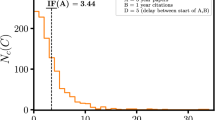Abstract
The hypothesis proposed by the author expresses that Zipf's law is only fulfilled on rank distributions which correspond to highly integrated (closed) subject fields. This hypothesis was tested on vast amount of empirical data. It was shown that document files in integrated fields are characterised by thematic, chronological (and sometimes geographical) closedness, as well as closedness by citation. Relationships were found between empirical facts usually considered in isolation within the frameworks of different scientometric and bibliometric theories (the theory of information concentration and scattering, obsolescence theory, theory of changing source productivity).
Similar content being viewed by others
References
G. M. DOBROV, Prognoznoye obespecheniye programmnogo upravleniya (Forecasts in support to programme management), In:IV Kiyevskij simposium po naukovedeniyu i nauchno-tekhnicheskomu prognosirovaniyu, P. II, Naukova Dumka, Kiev, 1972, 197–256.
G. M. DOBROV, A. A. KORENNOJ, Nauka: informatsiya i upravleniye (informatsionnyye problemy upravleniya naukoj). (Science: information and management. Information problems in science management),Sovetskoye radio, Moskva, 1977, p. 256.
G. M. DOBROV, R. H. RANDOLPH, R. W. D. RAUCH, Information networks for international team research,Telecommunication Policy, (Dec. 1978), 282.
A. A. KORENNOJ, Informatsionnyye modeli v upravlenii naukoj (Information models in science management),Naukovedeniye i informatika, 22 (1981) 36.
M. V. ARAPOV, A. N. LIBKIND, O ponyatii zamknutogo informatsionnogo potoka (On the notion of a closed information flow),Nauchno-tekhnicheskaya informatsiya, Seriya 2: Informationnyye protsessy i sistemy No. 6 (1977) 1.
M. V. ARAPOV, A. N. LIBKIND, Nauchnyye dokumenty v zerkale informatiki (Scientific documents from the informatics viewpoint),Voprosy informatsionnoj teorii i praktiki, No. 47 (1982) 47.
G. K. ZIPF,Human Behaviour and the Principle of Least Effort, Cambridge (Mass.), 1949.
S. C. BRADFORD, Sources of information on scientific subjects,Engineering, 137 (1934) 85.
S. C. BRADFORD,Documentation, Grossby Lockwood, London, 1948, p. 156.
A. J. LOTKA, The frequency distribution of scientific productivity,Journal of the Washington Academy of Sciences, 16 (1926) 317.
B. C. BROOKES, Bradford's law and the bibliography of science,Nature, 224 (1969) 953.
B. C. BROOKES, Theory of the Bradford law,Journal of Documentation, 33 (1977) 180.
B. C. VICKERY, Bradford law of scattering,Journal of Documentation, 4 (1948) 198.
V. I. GOR'KOVA, Rangovoye raspredeleniye na mnozhestvakh nauchno-tekhnicheskoj informatsii (Rank distribution on the sets within the scientific and technical information context),Nauchno-tekhnicheskaya informatsiya, Seriya 2: Informatsionnyye protsessy i sistemy, No. 7 (1969) 5.
V. I. GOR'KOVA, Sistemnnye issledovaniya dokumental'nogo informatsionnogo potoka (Systems approach to study the documentary information flow), In:Sistemnyye issledovaniya, Ezhegodnik, 1979, Nauka, Moskva, 1980, p. 240–266.
V. I. GOR'KOVA, A. I. CHERNY, Referativnomu zhurnalu “Informatika” 15 let (opyt sistemnogo analiza) (The abstracting journal “Informatics” is 15 years old — an attempt of systems analysis),Nauchno-tekhnicheskaya informatsiya, Seriya 1, No. 3 (1978) 1.
L. S. KOZACHKOV, Nekotoryye osobennosti raspredeleniya Zipfa-Bradforda i ego prilozheniya v informatike i naukovedenii (Some peculiar features of Zipf-Bradford distribution and its applications in information science and science of science),Naukovedeniye i informatika, Resp. mezhved. sb., 1 (1969) 81.
L. S. KOZACHKOV,Sistemy potokov nauchnoj informatsii (Flow Systems in Scientific Information), Naukova Dumka, Kiev, 1973, p. 196.
L. S. KOZACHKOV, Informatsionnye systemy s ierarkhicheskoj (“rangovoj”) strukturoj (Information systems with a hierarchical (ranked) structure),Nauchno-tekhnicheskaya informatsiya, Seriya 2: Informatsionnyye protsessy i sistemy, No. 8 (1978) 15.
B. MANDELBROT, O rekurentnom kodirovanii, organichivayuschem vliyaniye pomekh (On recurrent coding to limit the influence of noise), In:Teoriya peredachi soobschenij, Inostrannaya Literatura, Moskva, 1967, p. 139–157.
A. T. MITSEVICH, Issledovaniye struktury potokov nauchnotekhnicheskoj informatsii po machinostroyeniyu (An investigation into the structure of scientific and technical information flows in mechanical engineering),Nauchno-tekhnicheskaya informatsiya, Seriya 2: Informatsionnyye protsessy i sistemy, No. 5 (1975) 3.
A. T. MITSEVICH, Avtomatisatsiya processov proyektirovaniya sudov i informatsionnoye obespecheniye (Computerised processes in ship design and information support), VINITI, Moscow, 1975, p. 296.
A. T. MICEVIC, Mathematisches Modell zur Analyse dokumentaler Informationsströme, In:Dokumentation/Information, Institut für Informationswesen, Erfindungsw. und Recht Techn. Hochsch, Ilmenau, Teil 1, 1978, p. 103–114.
YU. K. ORLOV, Obobschennyj zakon Zipfa-Mandelbrota i chastotnyye struktury informatsionnykh edinits razlichnykh urovnej (The generalised Zipf-Mandelbrot law and frequency structures of information units of different levels), In:Vychislitel'naya lingvistika, Nauka, 1976, p. 179–202.
A. CHONEZ, La dispersion de la littérature periodique en science de l'information ou l'imposture pseudo de la loi de Bradford,Documentaliste, 11 (1974) 175.
Yu. A. SHREIDER, Slozhnyye sistemy i kosmologicheskiye printsipy (Complex systems and cosmological principles), In:Sistemnyye issledovaniya, Ezhegodnik, 1975, Nauka, Moskva, 1976, p. 149–171.
YU. A. SHREIDER, A. A. SHAROV, Sistemy i modeli (Systems and models),Radio i svyaz', Moskva, 1982, p. 152.
M. V. ARAPOV, E. N. EFIMOVA, Yu. A. SHREIDER, O smysle rangovykh raspredelenij (On the meaning of rank distributions),Nauchno-tekhnicheskaya informatsiya, Seriya 2: Informatsionnyye protsessy i sistemy, No. 1 (1975) 9.
M. V. ARAPOV, E. N. EFIMOVA, Ponyatiye leksicheskoj struktury teksta (The notion of lexical structure of a text),Nauchno-tekhnicheskaya informatsiya, Seriya 2: Informatsionnyye protsessy i sistemy, No. 6 (1975) 3.
A. DO ESPIRITO SANTO,A measure of the Dimensions of Interdisciplinarity of Two Applied Sciences, A Scientometric Model, University of Wiscontin, Madison Wisc., 1978.
M. V. ARAPOV, V. N. VERESCHAKO, A. N. LIBKIND, Programmy dlya issledovaniya rangovykh raspredelenij (Programs for the study of rank distributions),Algoritmyi programmy: inform. byul., No. 3 (1975) 17.
A. N. LIBKIND, E. B. RUDNIK, K probleme ispol'zovaniya periodicheskykh i prodolzhayuschikhsya izdanij (On the problem of use of periodicals and serials),NTI v stankostroitel'noj i instrumental'noj promyshlennosti) No. 3 (1983) 18.
M. V. ARAPOV, A. N. LIBKIND, Izmeneniye produktivnosti regulyarnykh istochnikov informatsii (Changes in prodicitivity of regular information sources),Nauchno-teknicheskaya informatsiya, Seriya 2: Informatsionnyye protsessy i sistemy, No. 10 (1976). 3.
Author information
Authors and Affiliations
Rights and permissions
About this article
Cite this article
Libkind, A.N. One approach to study communication in science. Scientometrics 8, 217–231 (1985). https://doi.org/10.1007/BF02016937
Received:
Issue Date:
DOI: https://doi.org/10.1007/BF02016937




